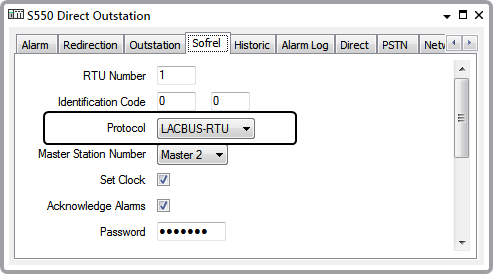Upload Configuration and Parameters
Associated with: Sofrel S500 Series Outstations.
Security permission required to access this pick action: Configure.
The Upload Configuration and Parameters action is available for Sofrel S500 series outstations using the LACBUS-RTU protocol. These outstations are pre-configured before being connected and setup within ClearSCADA. You can use the Upload Configuration and Parameters action to upload the configuration and operating parameters of points from the outstation when you have configured the following Sofrel items:
- Sofrel Channel (see Configuring a Sofrel Channel)
- Sofrel Outstation Set (see Configuring a Sofrel Outstation Set)
- Sofrel Outstation (see Configuring a Sofrel Outstation)
When you select the Upload Configuration and Parameters action the configuration for each point that exists within the outstation is created within ClearSCADA, within the same group as the outstation. If the points already exist in the database they are just updated.
Call recipients that are configured in the outstation are also be uploaded, however this doesn't include Master Station and Remote Terminal Unit recipients as these cannot be uploaded. (see Sofrel Call Recipients).
The following settings are uploaded for each point:
- Point label — If the point does not exist the label is used to the name the point. Existing points are not renamed. If a point has no label, then a default name is generated based on the point number: "Point <n>", <n> is point number. The label is stored in the ClearSCADA database and is shown in the view dialog as the RTU Label, (see Sofrel Point Status Attributes).
- Point Number
- Point type
- Point Units — This applies to analog and counter points only.
- Point State descriptions — This applies to digital points only. If the corresponding point in ClearSCADA is a multi-bit digital point (either, 2-bit or 3-bit), then the all state descriptions are discarded on upload as Sofrel outstations only support 1 bit digital points.
- Analog output point control range — The control range is always set, if the import creates the point this is used to set the range of the point (full scale / zero scale). If the import creates the point then the override range and trend range of the point are set to the engineering range.
- Archiving — This is used to enable the historic setting and to set the historic filter (it does not disable the historic setting of existing points).
- RTU Label, RTU description and Serial number are all included, see Sofrel Specific Status Display Attributes.
This action is only available if the protocol for the outstation is set to LACBUS-RTU.

If the upload includes the configuration of points that do not exist in ClearSCADA, ClearSCADA creates the appropriate points automatically in the same group as the outstation item. If the point already exists in the ClearSCADA database, ClearSCADA just updates the configuration settings to match those of the upload.
LOSS OF CONFIGURATION CHANGES
Uploading to Group Instances
If you are going to upload the configuration, and the Outstation or any of its points are in a Group Instance, you need to be aware of:
- Property Overrides
If the necessary Property Overrides are not defined, ClearSCADA will be unable to write the changes to the database and the upload process will be unsuccessful. For more details, see Property Overrides.
- The Point Conversion Process
As part of the upload process, ClearSCADA may attempt to change the type of existing points in the ClearSCADA database. For example, it may attempt to convert an Analog Input into a Digital point so that it matches the configuration being imported. This conversion cannot take place if the point is in a Group Instance, as its type is determined by the matching point in the Group Template.
If you upload configuration into items in a Group Instance (the Outstation or any of its points), ClearSCADA has to determine which configuration to use. It compares the uploaded configuration settings to those that are already in place in the ClearSCADA database, on a field-by-field basis. If the upload configuration settings are different to those in ClearSCADA , ClearSCADA checks if the required Property Overrides are defined. If they are, the upload configuration overwrites the existing configuration. Any settings that are the same as those in ClearSCADA are discarded. If the upload contains points that do not exist in ClearSCADA, new items are created to store the configuration. These new items are created automatically.
If an upload fails as a result of missing Property Overrides or point conversions being required, ClearSCADA lists the configuration errors in a configuration report (see Configuration Reports for Sofrel Outstations). There are no changes made to the ClearSCADA database.